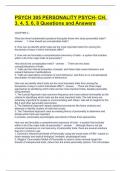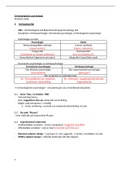PSYCH 305 PERSONALITY PSYCH- CH.
3, 4, 5, 6, 8 Questions and Answers
CHAPTER 3 -
What are three fundamental questions that guide those who study personality traits? -
answer 1. How should we conceptualize traits?
2. How can we identify which traits are the most important traits from among the
thousands of ways in which individuals differ?
3. How can we formulate a comprehensive taxonomy of traits - a system that includes
within it all of the major traits of personality?
How should we conceptualize traits? - answer There are two basic
conceptualizations of traits.
1. Traits are the internal properties of people, and these traits cause behaviour and
outward behaviour manifestations
2. Traits are descriptive summaries of overt behaviour, and there is no conceptualized
assumption of traits being causers of behaviours
How can we identify which traits are the most important traits from among the
thousands of ways in which individuals differ? - answer There are three major
approaches to identifying which traits are the most important traits, despite personality
being abstract.
1. The Lexical Approach uses synonym frequency and cross-cultural universality as the
criteria for identifying which traits are the most important traits. The trait terms are
extremely important for people in communicating with others. Has led to insights for the
Big 5 and other personality taxonomies
2. The Statistical Approach adopts statistical procedures like factor analysis and
attempts to identify clusters of traits that covary
3. The Theoretical Approach uses an existing theory of personality to determine and
dictate which traits are important.
In practice, personality psychologists use blends of these three approaches
How can we formulate a comprehensive taxonomy of traits - a system that includes
within it all of the major traits of personality? - answer Although there is not yet
universal consensus on one taxonomy of personality traits, there are several solutions
that are in common use.
1. Eysenck's Hierarchical Model of Personality using the broad traits of PEN - based on
factor analysis and explicit biological, heritable, physiological basis
2. Wiggins' Cirucumplex Model of Personality is used to more narrowly target the
domain of interpersonal traits, rather than the entire personality sphere. This Circumplex
,Model of Personality is organized around two key dimensions - Status(dominance) and
Love(agreeableness)
3. The Big Five Model of Personality is a taxonomy that includes the circumplex in that
the first two traits in the model, Extraversion and Agreeableness roughly align with
Status(dominance) and Love(agreeableness). In addition, the Big Five Model of
Personality includes Conscientiousness, Emotional Stability/Neuroticism and
Openness/Intellect. Recent evidence has pointed to a 6th trait, leading to the ...
4. HEXACO Model of Personality expands the Big Five with the addition of
Honesty/Humility
Some now argue for the cross-cultural robustness of the HEXACO model. This model is
likely the most important advance in personality taxonomy in the past 20 years.
What are two basic formulations of traits? - answer Internal Causal Properties: The
basic building blocks of personality; universal dimensions with individual differences.
aka internal causal properties that are carried across situations causing behaviour and
emotions
Descriptive Summaries of Behaviour: Almost any adjective(or sometimes noun) that
describes the way some people are and others are not aka purely descriptive
summaries of behaviours expressed with no causal properties
Includes the Act Frequency Approach
Define traits as internal causal properties - answer Psychologists who view traits as
internal dispositions/internal causal properties do not equate traits with the external
behaviour in question. This is because they believe that traits can lie dormant in the
sense that the capacities remain present even when connected behaviours are not
expressed. Traits(internal needs, drives, desires, etc) are presumed to exist even in the
absence of behaviour
What is an important consideration of how traits are conceptualized in the internal cause
theory? - answer They must be considered as dimensions of traits on which people
differ. For any given trait, some people are high, some are low and many are in the
middle
What is the scientific usefulness of viewing traits as internal causers of behaviour? -
answer It allows us to implicitly rule out other potential causers for behaviour, which
is very different from merely assuming traits are descriptives.
Define traits as purely descriptive summaries - answer Psychologists who view traits
as descriptive summaries of attributes of people make no assumptions about internality
or causality.
The descriptive summary perspective merely defines expressed behaviour. It may be
possible that traits have internal causers, but they may also be due to social situations,
aka, situational causers.
,These psychologists argue that we must first identify and describe the important
individual differences among people, and then create theories to explain them
What approach contrasts the conception of traits as dimensions? - answer The
categorical approach, like the Myers-Briggs, which attempts to describe people more
strictly in terms of a limited number of personality types.
**Personality research has consistently demonstrated that traits do exist as dimensions
and not types
Define trait-descriptive adjectives - answer Words that describe traits, attributes of a
person that are characteristic of a person and perhaps enduring over time. There are
approximately 20, 000 in the english language
What is another word for traits? - answer Dispositions
Define the act frequency formulation of traits. - answer Part of the descriptive
summary formulation - the act frequency formulation of traits starts with the theory that
traits are categories of acts. For example:
Dominance is a trait category that has hundreds of different qualifying actions...one is
considered to be dominant if they have a strong frequency of dominant actions.
Within the Act Frequency Formulation of Traits, a trait like dominance is a descriptive
summary of behaviour.
It is a program of research based on the descriptive summary formulation of traits, and it
starts with the notion that traits are categories of acts
Identify the three key elements to the Act Frequency Formulation of Traits(as used in
the Act Frequency Research Program) - answer 1. Act Nomination
2. Prototypicality Judgement
3. Recording of Act performance
Define Act Nomination - answer Within the Act Frequency Research Program, Act
Nomination is a procedure designed to identify which acts belong in which trait
categories. For example:
Dominance, or Impulsive are traits that have hundreds of acts specific to the trait
category
Define Prototypicality Judgement - answer Within the Act Frequency Research
Program, Prototypicality Judgement is the second step, which identifies which acts are
most central or prototypical of each trait category.
Define Recording of Act Performance - answer Within the Act Frequency Research
Program, Recording of Act Performance is the third step, which secures information on
the actual performance of individuals in their daily lives. S- Data or O-Data is how they
collect this information.
, Some trait categories that have been studies include:
Impulsivity, conscientiousness, extraversion.
Identify key criticisms of the Act Frequency Formulation. - answer 1. The technical
implementation does not specify how much context should be included in the
description of a trait-relevant act.(relationships, activities, motivations etc - what's the
context?)
2. It seems that the Act Frequency Formulation is applicable to overt, obvious actions,
but does not consider failures to act, and does not consider covert acts that are not
directly observable.
Identify accomplishments of the Act Frequency Formulation. - answer 1. Due to the
Act Frequency Formulation, behavioural phenomena of traits has been made explicit.
Remember, the primary way we know about traits is through their expressions in actual
behaviour
2. The Act Frequency Formulation is also helpful in identifying trait/ behavioural
regularities which are phenomena that must be explained by any comprehensive
personality theory.
3. The Act Frequency Formulation is also helpful in exploring the meaning of some traits
that are difficult to study, like impulsivity, conscientiousness and creativity.
4. The Act Frequency Formulation is also helpful in identifying cultural similarities and
differences in the behavioural manifestation of traits.(ie: shyness is different between
America and the Philippines)
5. The Act Frequency Formulation is also helpful to identifying domains of insight in
personality...ie: The more observable the actions, the higher the agreement between S-
Data and O-Data.
6. The Act Frequency Formulation can be used to predict important outcomes in
everyday life such as job success, salary, promotions etc.
Name the three approaches that have been used to identify important traits. - answer
1. Lexical Approach
2. Statistical Approach
3. Theoretical Approach
Define the Lexical Approach to identifying important traits - answer States that ALL
important individual differences have become encoded within the natural language.
Over ancestral time, the differences between people that were important were noticed
and useful words were invented to communicate about those differences. ie: dominant,
creative, reliable, etc. There are approximately 18, 000 trait-descriptive adjectives in
English.





